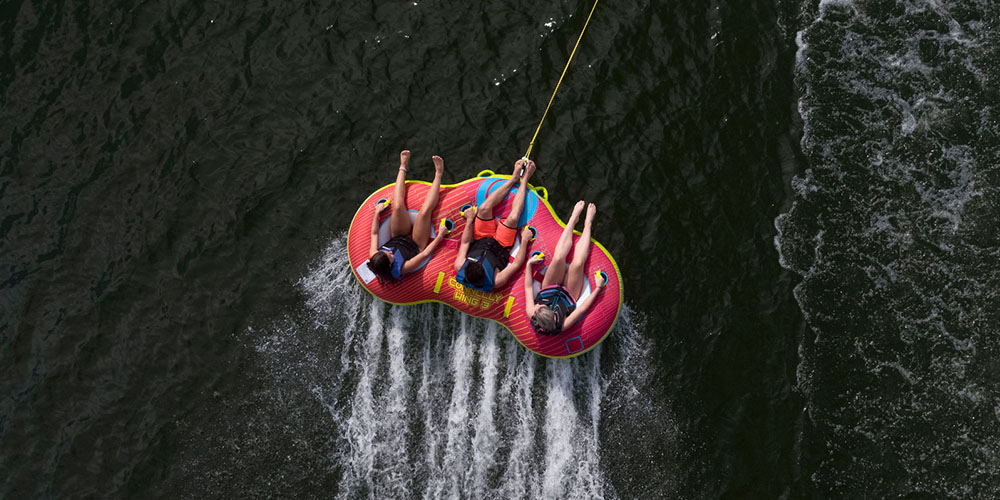
If you've ever hopped on a tube and got hauled around behind a boat, you know just how fun towable tubes can be and if the typical donut shaped towable is all you can picture, then there's a world of awesome towables for you to discover.
Brands like Airhead, Rave Sports and HO Sports are constantly coming out with new and exciting designs and there are a bunch of new ones hitting the water for 2024. Whether you're after a fast, exhilerating ride or a leisurely cruise behind the boat, we'll walk you through the main things to consider to find the right towable for your boat as well as the right ropes and accessories.
Tube Basics: Types of Tubes and Tube Designs
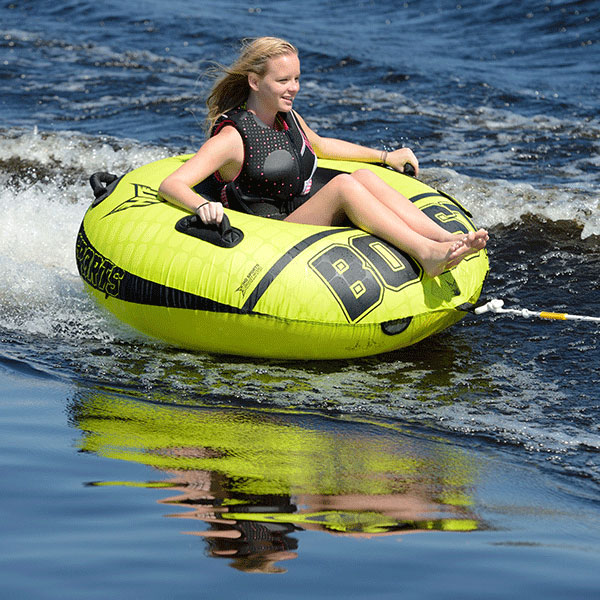
Always read your owner’s manual. Inflatables are built for different weight limits, ages, boat speeds and riding styles.
When space is an issue, consider buying a single person or two person tube. These affordable tubes are lighter and won't overwhelm your boat once inflated. There are some larger two-person tubes on the market, so remember to check the dimensions if you need a more compact sized tube.
If you have younger children or your riders wants to do some side-by-side riding, consider getting a multi-person tube. Knowing what kind of ride your riders want is one of the key components of providing a fun, carefree day on the water. Younger children or first-timers may want a buddy to ride along with them while older children and adults enjoy the camaraderie multi-person tubes promote.
Be sure you are not towing more people than the specified number of riders required for your particular tube. Adding additional riders above the manufacturer's recommendations is dangerous because there are only enough handles for the specified number of riders on the tube. According to HO Sports, one of our popular towable brands, exceeding the weight limit of your towable runs the risk of damaging and compromising the integrity of your tube resulting in unsafe conditions for riders.
Along with choosing the number of riders for your tube, choosing a design is just as important. Different designs accommodate different rider levels, ages and speeds while changing the experience for the rider.
Open top tubes
The original towable, these donut style tubes are versatile and popular for all ages and rider levels. You can ride this tube in several different ways, maximizing your fun. For a more relaxed ride, ride with your bottom in the middle and your feet draped over the side. For a more thrill-seeking ride, lie on your belly with your head forward and feet toward the back. Some open top tubes have larger holes and are better suited for larger kids, teens and adults—always check the tube's dimensions.
Deck tubes

Deck tubes offer a fast ride and require a stronger grip to stay onboard. With a large, flat surface, lying on your belly and holding on for dear life is the best way to ride one of these popular tubes. The design lends itself to flipping over after hitting a wake or wave, but the large, flat surface makes it easy to board after falling off. And don't worry, falling off is part of the fun!
Hybrid deck tubes offer various modifications to the deck tube for riders seeking a dynamic, wild ride. For example, some incorporate stability or leverage fins to help keep you on while fighting centrifugal force during fast whips.
Ride-in & cockpit style tubes
Ride-in/cockpit tubes are great for younger kids or those seeking a more timid, relaxed ride. Riders sit low inside and toward the back of these tubes, resulting in a smoother take off and safer ride. Offered in a variety of shapes and sizes to accommodate one to four passengers, these tubes are stable and rarely flip over due to wakes and waves.
Dual tow point tubes
Popular tubes for families and great for all ages, dual tow point tubes offer two different styles of riding by adding tow points on two sides of the tube. In the seated front position, the riders get a comfortable backrest and stable ride. Tow the tube backward for a chariot-style ride where the riders sit on their knees. The chariot-style accommodates older kids and adults looking for a faster thrill.
Banana or toboggan style tubes
These tubes are designed to be straddled for a sled-like experience. Most are built to hold anywhere from one to six riders, while some can carry up to 10 people. Well-suited for pontoon boats due to their slim, aerodynamic profile, these tubes don't need as much speed to get going. Be sure to check the manufacturer speed recommendations as these types of tubes provide ample opportunities for riders to bump heads with one another.
Rocker tubes
A curved surface gives rocker tubes a distinct experience while giving the rider added maneuverability by allowing them to shift their weight from side to side. Rockers come in two designs for a truly dynamic ride: the three-stage and U-shaped. Three-stage rockers have winged tips on each side with a flat middle so riders can lie down or sit up. By shifting their weight, riders can ride high on one side or try to balance the tube in the middle. U-shaped rockers have a continuous curvature construction allowing riders to effortlessly rock side to side.
Built for more extreme riders due to the potential for harder whips and twists, rockers are exciting options for thrill seekers. If drivers avoid whips and higher speeds, younger children and first-timers can also enjoy rockers considering they tend to flip less than deck or open top tubes.
Unique concept tubes
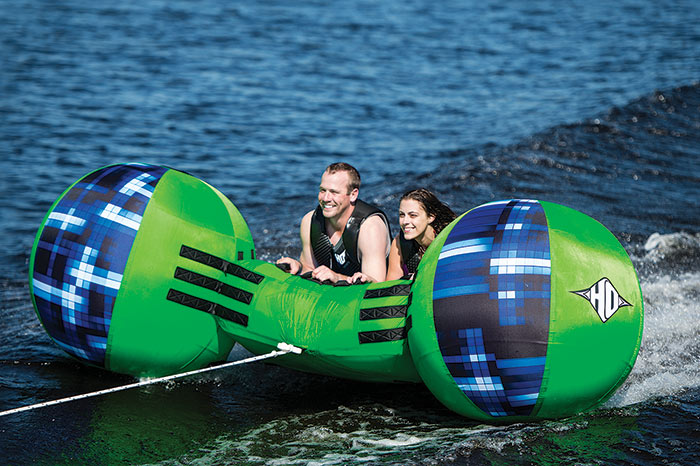 Always make sure your tube is properly inflated, has no damage or holes, is functional and secured properly to the tow rope and tow point before going on the water.
Always make sure your tube is properly inflated, has no damage or holes, is functional and secured properly to the tow rope and tow point before going on the water.
Thanks to adventure seekers everywhere, innovative tube designs are becoming more prevalent in the towing world. Concept tubes are unique and almost every manufacturer has an up and coming design never seen before. Built to meet the demands of high-performance riders, these tubes are designed to roll, fly off the wake or accommodate multiple seating arrangements. Typically more expensive than your standard tubes, these tubes are also geared toward more advanced riders.
Tow Ropes
According to the Water Sports Industry Association (WSIA), tube ropes must be at least 50 feet in length but not exceeding 65 feet. A rope shorter than 50 feet will tow the tube in the crest of the wake spraying the riders in the face. Ropes are designed for different sized tubes and using the wrong rope can cause damage to it. For example, using a four-person tube with a tow rope rated for a two-person tube can cause the rope to break.
Additionally, never use a tow rope that has knots, is frayed or sun damaged. Inspect your rope before each use to ensure structural integrity before going out on the water. Remember to only use ropes designed for tubing when towing an inflatable tube. Water ski, wakeboard or knee boarding ropes should not be used because they are not designed to pull the same amount of weight and do not have the same break strength (also referred to as tensile strength) as tubing ropes.
| Riders | Max Weight of Riders | Rope Tensile Strength |
|---|---|---|
| 1 | 170lbs. | 1,500lbs. |
| 2 | 340lbs. | 2,375lbs. |
| 3 | 510lbs. | 3,350lbs. |
| 4 | 680lbs. | 4,100lbs. |
| 5-6 | 850-1020lbs. | 6,100lbs. |
Note: Check with the manufacturer of your specific tube for tow rope specifications. The specifications outlined above are meant to be a guideline ONLY and are recommendations of the WSIA.
Shop our selection of towable ropes here.
Tow Points and How to Attach a Rope Correctly
Tow ropes should always be securely attached to the boat at an approved attachment point, such as a transom eye or low transom tow point. The best way to attach a tow rope is to attach it to a fitting or "ski eyelet" on the center of the stern. HO Sports recommends boaters push the loop of the rope through the hole in the center of the tow attachment, and then wrap the loop around the perimeter of the tow harness. They added that you should never tie a knot in your tow rope. Some inflatables come with a quick connect clip for easily attaching your tow rope to the tube, while others will have a designated attachment point for the tow rope.
Never pull your towable tube from a tower. Towers are not strong enough and the drag from the towable tube will put too much stress on the tower, possibly ripping it off your boat.
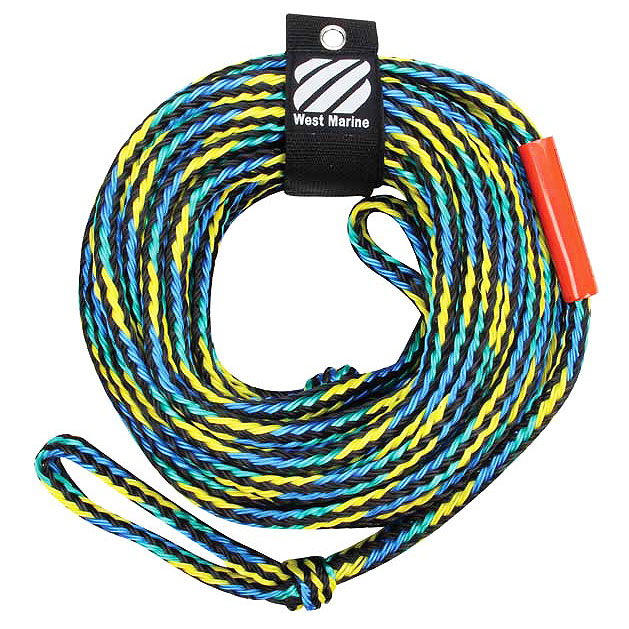
When not in use, wind up your tow rope and store it away from the sun.
If you're using a low tow point it can be difficult to keep the tow rope out of the water, causing drag. Lighter loads on the tube can also cause the rope to drag in the water as there is not enough tension on the rope. Adding a Booster Ball or Bobber in either of these situations will keep the tow rope out of water while enhancing the performance of your towable tube and improving tow rope visibility in the water. This is especially true for pontoon boats and low transom tow points.
Properly Inflating Your Towable
Towable tubes should be inflated until the tube is ultra-firm and the cover is wrinkle-free. Check your manufacturer recommendations for proper inflation and be aware that inflation levels can change due to the hot sun and water temperatures. When not in use, it is best to deflate, fold and store your towable where it will not be damaged by sunlight or get punctured.
Knowing the type of valve on your tube before getting out on the water will help save you some time and energy. Check your tube to see if you have a Boston valve, stem valve or a speed valve. Next, make sure you have the correct fitting on your electric pump.
- Boston valves are one-way valves with two caps. Pop off the top cap to fill your tube up with air. The valve let's air in, but won't let any air escape. To deflate, untwist the entire valve.
- Inflating a speed valve is easy. All you need is a speed valve fitting on your electric pump, place it in the valve and inflate.
- Stem valves are the simplest, most common valve on most inflatable toys. Place the electric pump deep inside the stem valve to inflate. Deflate by pinching the stem valve and pressing on the tube until the air is depleted.
For more information about proper tube inflation, watch the video blew from the experts at Kwik Tek.
Driver Tips and Safety
Pulling a tube is fairly easy and as long as drivers use common sense, they can create an exhilarating ride for tubers. Start off by pulling the tube inside of the wake. Once the riders are comfortable and you get a feel for the correct speed to keep the tube from submerging (or submarining) you can try some gentle S turns back and forth. The tube will then start moving over the wake, swinging from side to side.
Submarining is when the front of the tube dips into the water, sometimes diving all the way under the water. If this happens, make sure the riders position themselves a little farther back on the tube so their weight is on the back, accelerate, and once the tube pops up on the water or planes, you can turn up the speed. Also, check that your tube is properly inflated, you have the proper tow rope for your tube and that the tow rope is attached to your boat and the tube properly.
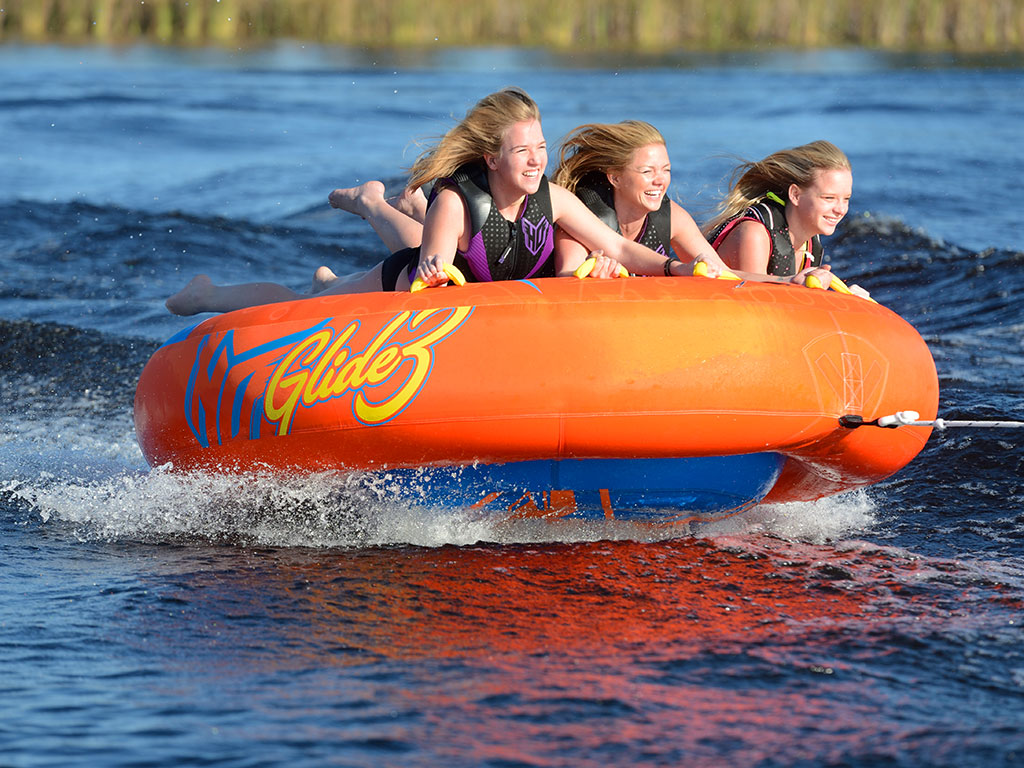
Making riders go over waves/wakes at high speeds may cause them to become airborne. While this may seem like a lot of fun, it also has the potential to cause serious back injuries. Please use caution.
Know your riders and develop hand signals for speeding up, slowing down and zigzagging over the wake. This will help riders communicate with you, ensuring they enjoy their ride. New riders and younger kids might not like a super-fast, aggressive ride while the older kids and adults will want to zip around at maximum speeds. Hand signals will help drivers make adjustments for specific rider's wants and needs.
Fast turns swing the tube around at an even higher speed for a whip effect. WSIA says inflatables can reach speeds up to 55mph while towing at 20mph during a whip, and tubes can swing outside the wake to the full length of the tow rope. This can be frightening for younger children and dangerous in areas of high traffic or near shores and obstacles. Pay attention to the tow rope slack as well. If the rope goes slack and then you accelerate too quickly, the tow rope suddenly rips the tube forward causing the rider to fall off or causing multiple riders aboard to bump heads.
Drivers should have a rear view mirror and a spotter at all times while towing riders on tubes. They should be aware of the tubes trajectory while the spotters should be alert to riders going overboard. A spotter should have a safety "tuber down" flag on hand for when the rider falls into the water. By signaling the flag in the air, other boaters will be alerted to the fact that a person is in the water.
When someone falls off of a tube, drivers should throttle down right away. Approach riders on the driver's side of the boat so they are in view and never blocked by the bow/hull. Drivers should go slow enough as to not make waves and so they can talk to/hear the rider. Always shut the motor off before riders swim up to the boat and when riders are getting into the water or on the towable.
Safety Precautions
Follow these basic guidelines to ensure maximum fun and optimal safety:
- Always wear a life jacket and make sure it is properly sized and securely fastened. Accidents happen and even the best swimmers can be caught off guard. Minimize your risks with a Type III life jacket, which is required equipment for all towable riders.
- Do not pull more than one tube at a time. If tubes cross paths and collide it can be very dangerous and cause serious injuries to the riders.
- Riders and drivers should use caution when towing or riding on multi-person tubes. Heads can collide easily, causing serious head or brain injury. Arms and legs can also knock into the person next to you after hitting a wake or wave.
- Drivers should be aware of pilings, docks and other boats while whipping and towing tubes to avoid serious injuries. Injuries usually occur due to the rider's position on the tube, lack of directional control and velocity of the tube, and the number of riders per tube. According to the Journal of Physical Activity and Health, the most frequently injured body parts were the head (27%) followed by the upper extremities at (24%). Most common types of injuries are sprains and strains followed by soft tissue injuries. Impact with the water and contact with another rider are the most common causes of injuries.
- Water regulations vary from state to state, so be sure to make yourself familiar with the regulations governing the specific body of water you are towing tubes on. For information on state boating laws, please refer to the National Association of State Boating Law Administrators' (NASBLA) website.
- According to the United States Coast Guard's 2015 Recreational Boating Statistics report, alcohol use is the leading factor in fatal boating accidents while operator inattention is the leading cause of accidents in general. Always be sure your driver is sober and aware of their surroundings at all times.
Towable Tubes and Tow Ropes FAQs
What is a towable tube?
A towable tube is an inflatable water toy designed to be pulled behind a boat, allowing riders to sit or lay on it while being towed over the water.
What types of towable tubes are available?
Towable tubes come in various styles, including single-rider, multi-rider, and deck tubes (flat), each designed for different riding experiences.
How do I choose the right towable tube?
Consider factors such as the number of riders, the type of riding experience you want (e.g., lounging vs. extreme), and the tube's weight capacity.
What is the recommended tow rope for tubes?
Use a specially designed tow rope for tubes, which is typically thicker and has a higher breaking strength than standard wakeboard ropes. Look for a rope rated for the weight of all riders combined.
How long should a tow rope for tubes be?
A tow rope length of 50 to 65 feet is common for towable tubes, providing enough distance between the boat and the tube for a safer ride.
Can I use a regular boat rope for towing a tube?
It’s not recommended. Regular boat ropes may not be strong enough and can stretch too much, increasing the risk of injury. Always use a dedicated tow rope.
How do I attach a towable tube to the boat?
Most tubes have a tow harness or strap. Simply loop the tow rope through the attachment point on the tube and secure it to the boat’s tow point.
What safety measures should I take when using towable tubes?
Ensure all riders wear life jackets, maintain a safe speed (usually 15-25 mph), and avoid sharp turns. Keep an eye on riders to watch for falls or difficulties.
How do I inflate and deflate a towable tube?
Use an air pump for quick inflation. Many tubes have Boston valves for easy inflation and deflation. Make sure to deflate and dry the tube before storing it to prevent mold.
How do I maintain my towable tube?
Rinse the tube with fresh water after use, avoid dragging it on rough surfaces, store it in a cool, dry place, and regularly check for punctures or wear.
Need More Help?
West Marine is the perfect place to get ready for any trip. With a crew of boaters in store, we have the know-how you need. Find your store here.